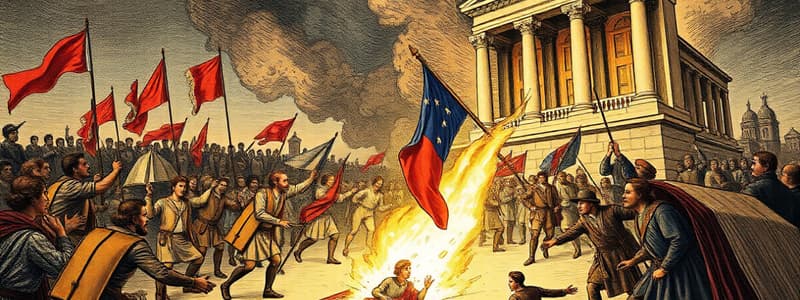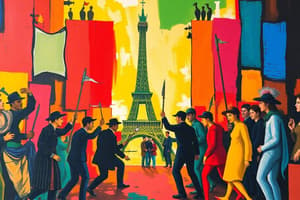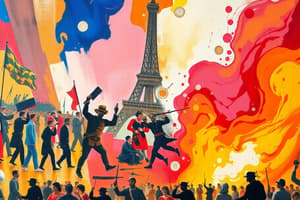Podcast
Questions and Answers
What was the primary goal of the Reign of Terror?
What was the primary goal of the Reign of Terror?
- To eliminate counter-revolutionary threats (correct)
- To restore the monarchy
- To establish peace with neighboring countries
- To promote Enlightenment ideals
The Declaration of the Rights of Man and of the Citizen was a document that outlined the rights of the French monarchy.
The Declaration of the Rights of Man and of the Citizen was a document that outlined the rights of the French monarchy.
False (B)
Name one significant outcome of the French Revolution.
Name one significant outcome of the French Revolution.
End of the French Monarchy
Maximilien Robespierre was a key figure during the ________.
Maximilien Robespierre was a key figure during the ________.
Match the following key figures with their roles:
Match the following key figures with their roles:
Which event is considered a pivotal moment in the French Revolution?
Which event is considered a pivotal moment in the French Revolution?
Which of the following factors significantly contributed to the economic hardship in France before the revolution?
Which of the following factors significantly contributed to the economic hardship in France before the revolution?
The French Revolution had no significant influence on other countries in Europe.
The French Revolution had no significant influence on other countries in Europe.
What ideals did the French Revolution widely spread across Europe?
What ideals did the French Revolution widely spread across Europe?
The first estate comprised the commoners and was subject to the same tax obligations as the nobility.
The first estate comprised the commoners and was subject to the same tax obligations as the nobility.
What was the primary goal of the National Assembly during the Moderate Phase of the French Revolution?
What was the primary goal of the National Assembly during the Moderate Phase of the French Revolution?
The _____ Phase of the French Revolution is characterized by the execution of Louis XVI and Marie Antoinette.
The _____ Phase of the French Revolution is characterized by the execution of Louis XVI and Marie Antoinette.
What inspired the revolutionary sentiment leading to the French Revolution?
What inspired the revolutionary sentiment leading to the French Revolution?
Match the phases of the French Revolution with their descriptions:
Match the phases of the French Revolution with their descriptions:
Rising bread prices were a contributing factor to the discontent among the peasantry before the revolution.
Rising bread prices were a contributing factor to the discontent among the peasantry before the revolution.
What was one major consequence of the financial crisis faced by the French government?
What was one major consequence of the financial crisis faced by the French government?
Flashcards
Storming of the Bastille
Storming of the Bastille
The event that marked the beginning of the French Revolution, symbolizing the people's defiance against the monarchy.
Declaration of the Rights of Man and of the Citizen
Declaration of the Rights of Man and of the Citizen
A document outlining fundamental human rights and freedoms that became a cornerstone of the French Revolution.
Reign of Terror
Reign of Terror
A period of intense political repression and violence during the French Revolution, marked by mass executions and the elimination of perceived enemies.
Louis XVI
Louis XVI
Signup and view all the flashcards
Maximilien Robespierre
Maximilien Robespierre
Signup and view all the flashcards
Napoleon Bonaparte
Napoleon Bonaparte
Signup and view all the flashcards
Impact of the French Revolution
Impact of the French Revolution
Signup and view all the flashcards
Influence on Europe
Influence on Europe
Signup and view all the flashcards
Royal Extravagance
Royal Extravagance
Signup and view all the flashcards
Three Estates System
Three Estates System
Signup and view all the flashcards
Enlightenment Influence
Enlightenment Influence
Signup and view all the flashcards
Economic Hardship
Economic Hardship
Signup and view all the flashcards
French Government Debt
French Government Debt
Signup and view all the flashcards
Moderate Phase
Moderate Phase
Signup and view all the flashcards
Radical Phase
Radical Phase
Signup and view all the flashcards
Thermidorian Reaction
Thermidorian Reaction
Signup and view all the flashcards
Study Notes
Causes of the French Revolution
- The French monarchy's extravagant spending, including lavish lifestyles and costly wars, severely strained the treasury and exacerbated existing economic inequalities.
- France's rigid social hierarchy, dividing citizens into three estates (clergy, nobility, and commoners), created profound resentment and inequality. The privileged first two estates enjoyed tax exemptions, while the majority third estate bore the tax burden, leading to widespread poverty and food shortages.
- Enlightenment ideals, promoting reason, individual rights, and popular sovereignty, challenged the legitimacy of absolute monarchy. Philosophers like Montesquieu, Rousseau, and Voltaire inspired revolutionary thought.
- Severe economic hardship, including widespread poverty, food shortages, and rising bread prices (due to poor harvests), fueled immense popular discontent, especially among the peasantry.
- The French government's financial crisis, stemming from decades of extravagant spending and costly conflicts, reached a critical point, with the government unable to meet its obligations.
Phases of the French Revolution
- Moderate Phase (1789-1792): Characterized by the storming of the Bastille, the Declaration of the Rights of Man and of the Citizen, and the establishment of a constitutional monarchy. The National Assembly aimed to create a limited monarchy, dividing power among various estates.
- Radical Phase (1792-1794): Marked by intense violence, the execution of Louis XVI and Marie Antoinette, and the Reign of Terror under Robespierre. Rising instability led to radical measures.
- Thermidorian Reaction (1794-1795): A reaction against the Reign of Terror, resulting in a more moderate, conservative government, ending the radical phase.
- The Directory (1795-1799): A five-member executive body that replaced the Reign of Terror. The Directory struggled with political chaos and corruption, ultimately failing to establish lasting stability.
Key Events and Figures
- Storming of the Bastille (1789): A pivotal moment representing the people's rejection of royal authority, becoming a powerful symbol of the revolution.
- Declaration of the Rights of Man and of the Citizen (1789): Outlined fundamental rights (liberty, property, security), providing a theoretical foundation for the revolution.
- The Reign of Terror (1793-1794): A period of mass executions and political repression under Robespierre to eliminate counter-revolutionary threats.
- Louis XVI and Marie Antoinette: The French monarch and queen, whose execution was a significant turning point.
- Maximilien Robespierre: A key figure during the Reign of Terror, instrumental in the revolution's radicalization. His downfall signaled the end of the Reign of Terror.
- Napoleon Bonaparte: A prominent military leader instrumental in bringing the revolution's radical phase to an end.
Outcomes of the French Revolution
- End of the French Monarchy: The revolution abolished the absolute monarchy and ushered in a republican government.
- Spread of Enlightenment Ideals: The ideals of liberty, equality, and fraternity spread throughout Europe and beyond, fundamentally challenging existing social and political orders.
- Rise of Nationalism: French national identity deepened during the revolution, shaping the nation's political and social fabric.
- Rise of Napoleon: Political instability following the revolution enabled Napoleon's rise and subsequent imperial rule.
- Social and Economic Reform: While facing setbacks, some social and economic reforms occurred, primarily concerning rights and freedoms for members of the third estate.
Impact on Europe
- The French Revolution and Napoleon's subsequent campaigns dramatically reshaped European political and social landscapes.
- The revolution provided a model for other movements seeking political and social change across Europe.
- The French Revolution remains a pivotal moment in European history, triggering immense societal unrest and inspiring transformative change.
Studying That Suits You
Use AI to generate personalized quizzes and flashcards to suit your learning preferences.




